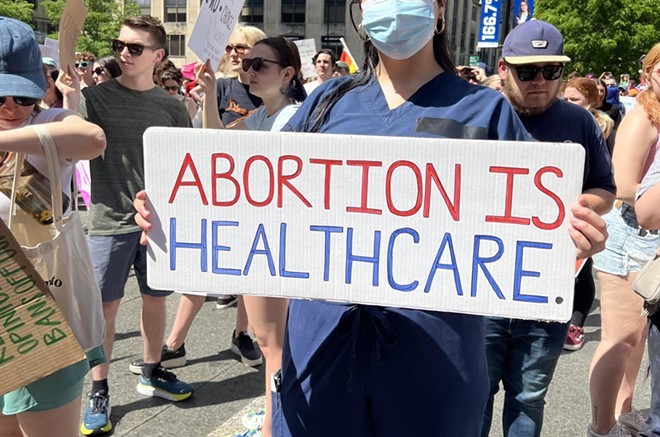
Madeline Fening
A nurse holds a sign in support of abortion access at a Planned Parenthood rally in Downtown Cincinnati on May 15, 2022.
Between June 24, the day the Supreme Court struck down Roe v Wade and the constitutional protection of a right to abortion via its decision in the Dobbs v Jackson Women’s Health Organization case, and August 2022, there was a 65% decrease in the number of abortions performed in Ohio, according to data collected by the Society of Family Planning.
Many states, including Ohio, either had trigger laws in place which immediately made abortion illegal or severely restricted access to it or quickly passed legislation to do the same, leading to a nationwide decrease of 6%.
The Supreme Court ruling paved the way for Ohio's "Heartbeat Law," passed in 2019 but previously held up in court, to go into effect, banning abortion after six weeks. It included no exceptions for rape or incest, and many abortion seekers, including a 10-year-old rape victim, various minors and others, were forced to travel out of state after Senate Bill 23 became law.
That law is now indefinitely on hold after an order by a Hamilton County judge in a lawsuit brought by Preterm Cleveland and others against the state, meaning Ohioans can still legally have an abortion up to 22 weeks into pregnancy.
“Abortion is safe health care to which Ohioans have a right,” Judge Christian Jenkins wrote. “... Patients denied abortion services because of S.B. 23 are often under great distress from, for example, not being able to obtain treatment for life threatening cancers, or from fearing job loss and an inability to provide for their families because they must arrange travel out of state on short notice, often without the resources to do so.”
But in the stretch between the Supreme Court ruling and the Ohio judge's order, Ohioans faced a draconian six-week limit and many who had the resources, or were provided them by abortion funds or support organizations, did travel to other states where the right to abortion was better protected.
Those states saw an increase in procedures from April to August of this year, according to the #WeCount report — 12% in New York, 7% in New Jersey and 28% in Illinois, for example.
There was also a jump in virtual appointments.
“Notably, abortions provided by virtual-only clinics increased from 2,830 in April 2022 (3% of total abortions), before the decision, to 3,780 in August 2022 (4.7% of all abortions). This change represents an increase of 33% in the number of abortions provided from virtual-only services, comparing April and August 2022," according to the report.
There were 1,950 abortions performed in Ohio in April and just 680 in August, though, and about 2,470 fewer people than normal had abortions in the state during the June through September window.
The data included in the #WeCount report is provided by clinics, private medical offices, hospitals, and virtual-only providers throughout the United States. The report does not include any self-managed abortions, where one may attempt to end their own pregnancy without medical supervision and which may include the use of Aid Access services.
Many expect Ohio to pass a complete abortion ban in the coming lame duck session.

